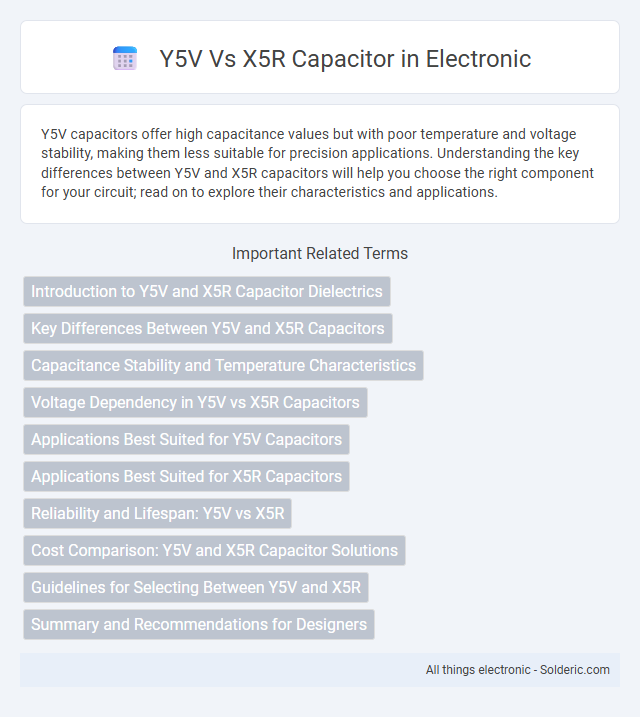Y5V capacitors offer high capacitance values but with poor temperature and voltage stability, making them less suitable for precision applications. Understanding the key differences between Y5V and X5R capacitors will help you choose the right component for your circuit; read on to explore their characteristics and applications.
Comparison Table
| Feature | Y5V Capacitor | X5R Capacitor |
|---|---|---|
| Dielectric Type | Y5V (High Permittivity) | X5R (Temperature Stable) |
| Temperature Range | -30degC to +85degC | -55degC to +85degC |
| Capacitance Tolerance | +22% / -82% | +-15% |
| Temperature Coefficient | +22% / -56% over range | +-15% over range |
| Capacitance Stability | Low - varies widely with temperature | Moderate - stable within tolerance |
| Application | General purpose, non-critical circuits | Decoupling, filtering, moderately critical circuits |
| Cost | Lower cost | Higher cost |
| Reliability | Lower reliability | Higher reliability |
Introduction to Y5V and X5R Capacitor Dielectrics
Y5V and X5R capacitor dielectrics differ primarily in temperature stability and capacitance tolerance; Y5V offers high capacitance but with wide tolerance (-20% to +80%) and limited temperature range (-30degC to +85degC), making it suitable for non-critical filtering tasks. X5R dielectrics provide better temperature stability (-55degC to +85degC) and tighter capacitance tolerance (+-15%), ideal for decoupling and timing applications requiring moderate stability. Understanding these characteristics helps you select the right capacitor dielectric for your circuit's performance and reliability needs.
Key Differences Between Y5V and X5R Capacitors
Y5V capacitors offer high capacitance values at low cost but suffer from poor temperature stability and wide capacitance variance, with a typical tolerance of +-20% and operating temperature range of -30degC to 85degC. X5R capacitors provide better performance with moderate capacitance, tighter tolerance of +-15%, and improved temperature stability, operating reliably between -55degC and 85degC. The key difference lies in Y5V's high capacitance but limited reliability for critical applications, while X5R balances capacitance and stability suitable for general-purpose electronic circuits.
Capacitance Stability and Temperature Characteristics
Y5V capacitors offer high capacitance values but exhibit poor capacitance stability and significant variation over temperature, typically ranging from +22% to -82% within the -30degC to 85degC range. X5R capacitors provide better capacitance stability, with variations limited to +-15% across a broader temperature spectrum from -55degC to 85degC. These characteristics make X5R capacitors more suitable for applications requiring consistent performance under temperature fluctuations.
Voltage Dependency in Y5V vs X5R Capacitors
Y5V capacitors exhibit significant voltage dependency, causing their capacitance to vary dramatically under applied voltage, often losing up to 80% of their rated capacitance at rated voltage. X5R capacitors maintain more stable capacitance with voltage changes, typically losing no more than 15-20%, making them suitable for applications requiring consistent performance. The inherent material properties of Y5V dielectrics result in higher permittivity variation under electric fields compared to the more stable BaTiO3-based dielectric in X5R types.
Applications Best Suited for Y5V Capacitors
Y5V capacitors are best suited for applications requiring high capacitance in a small package with less emphasis on stability, such as in filtering, decoupling, and coupling circuits in consumer electronics. They exhibit a wide capacitance tolerance and significant temperature dependence, making them ideal for non-critical timing and bypass functions. Commonly used in power supply filters and audio equipment, Y5V capacitors balance cost and size at the expense of precision.
Applications Best Suited for X5R Capacitors
X5R capacitors are best suited for applications requiring stable capacitance over a moderate temperature range, such as decoupling and filtering in power supply circuits for smartphones, computers, and automotive electronics. Their ability to maintain capacitance with minimal variation under voltage stress makes them ideal for high-frequency applications and analog circuits. Choosing an X5R capacitor ensures improved performance and reliability in systems where maintaining consistent capacitance is critical to your device's operation.
Reliability and Lifespan: Y5V vs X5R
X5R capacitors offer higher reliability and longer lifespan compared to Y5V capacitors due to better temperature stability and lower capacitance variation over time. Y5V capacitors tend to degrade faster under thermal and electrical stress, resulting in reduced performance and shorter operational life. Choosing an X5R capacitor can significantly enhance the durability and consistent performance of your electronic circuits.
Cost Comparison: Y5V and X5R Capacitor Solutions
Y5V capacitors generally offer a lower cost solution compared to X5R capacitors due to their simpler materials and manufacturing process, making them ideal for budget-sensitive applications. X5R capacitors provide better temperature stability and capacitance tolerance, which can justify the higher investment when performance consistency is critical. Your choice between Y5V and X5R capacitors depends on balancing cost constraints with the required electrical characteristics for your specific application.
Guidelines for Selecting Between Y5V and X5R
Choose X5R capacitors when your application demands stable capacitance over a wide temperature range and low voltage sensitivity, ideal for power supply filtering and decoupling. Opt for Y5V capacitors if you need a compact, cost-effective solution with higher capacitance but can tolerate significant capacitance variation and limited temperature stability. Your selection should consider trade-offs between capacitance stability, temperature performance, cost, and physical size to ensure optimal circuit reliability.
Summary and Recommendations for Designers
Y5V capacitors offer high capacitance values at a lower cost but suffer from poor temperature stability and high capacitance tolerance, making them suitable for non-critical filtering applications. X5R capacitors provide better temperature stability and capacitance tolerance, ensuring reliable performance in decoupling and bypass scenarios in power supply circuits. Designers should select X5R capacitors for applications requiring stable capacitance across temperature variations and choose Y5V only for less demanding, cost-sensitive projects.
Y5V vs X5R capacitor Infographic

 solderic.com
solderic.com